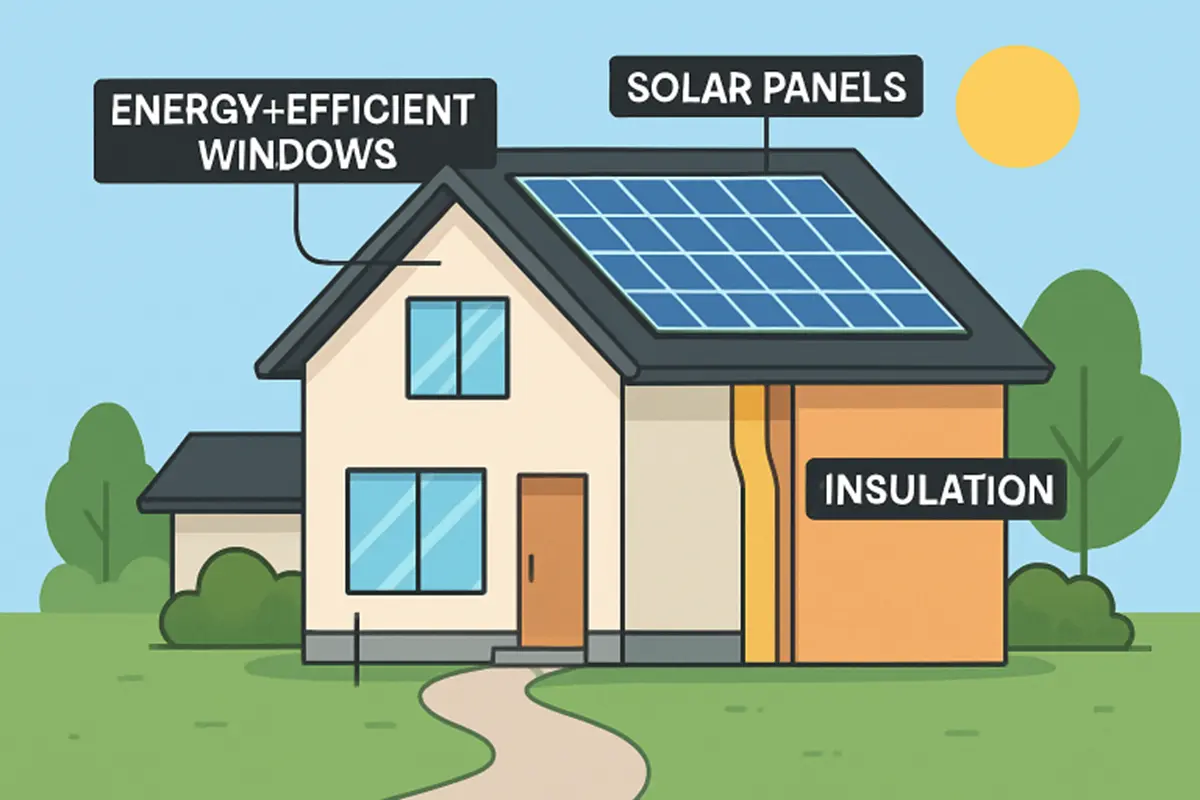Table of Contents
- Advanced Window Technologies
- Phase Change Materials (PCMs)
- Perovskite Solar Panels
- Vacuum-Insulated Panels (VIPs)
- Aerogel Insulation
- Structural Insulated Panels (SIPs)
- Thermochromic Windows
- Conclusion
Improving home energy efficiency is no longer just about upgrading insulation or sealing air leaks—it’s also about embracing modern materials that enhance performance and sustainability. Innovative construction components, from advanced glazing to composite framing, are transforming how homes retain heat in winter and stay cool in summer. These materials are engineered to reduce energy waste, minimize maintenance, and contribute to a more comfortable and eco-friendly living environment.
One standout example of this innovation is the advantages of Fibrex windows. Made from a blend of recycled wood fibers and thermoplastic polymer, Fibrex provides superior insulation compared to traditional materials. It resists warping, cracking, and thermal expansion, maintaining a tight seal that keeps conditioned air inside. This combination of strength, efficiency, and longevity makes Fibrex an ideal choice for homeowners seeking to lower their energy costs and promote long-term sustainability without compromising on style or durability.
Advanced Window Technologies
Windows are critical to a home’s energy profile. Traditional double-pane or single-pane glass is prone to letting heat escape in winter and enter in summer, which can force heating and cooling systems to work overtime. Fortunately, advanced solutions like nanotechnology-driven coatings now offer homeowners a way to enhance their window performance significantly. Notably, an innovation from Rice University uses a boron nitride and carbon-based coating to reflect infrared heat and provide UV resistance. This durable application can be retrofitted to existing windows, acting almost like an armor that significantly lowers utility bills and increases occupant comfort.
Phase Change Materials (PCMs)
PCMs integrate unique thermal properties into building materials. When integrated into walls, ceilings, or flooring, these substances absorb, store, and release heat as they transition between solid and liquid states. This process creates a buffering zone, evening out temperature swings indoors and reducing reliance on air conditioning or heating units. For instance, the University of Coimbra’s recent research in Portugal has demonstrated real-world reductions in energy consumption by embedding PCMs in residential construction, allowing buildings to effectively “store” thermal energy during peak sunshine hours and release it at night. These developments are poised to reshape building codes in climates with high diurnal temperature variation.
Perovskite Solar Panels
Solar electricity is no longer limited to bulky rooftop panels or expensive installations. The introduction of perovskite-based solar cells is driving a leap in efficiency and design flexibility. Unlike traditional silicon panels, perovskite cells are lightweight, flexible, and suitable for integration directly into windows, building surfaces, or even vehicle exteriors. Researchers at the University of Oxford have achieved conversion efficiencies exceeding 27%, surpassing those of many standard photovoltaic products. The implications are tremendous for urban environments, where maximizing usable surface area for power generation is essential.
Vacuum-Insulated Panels (VIPs)
VIPs are revolutionizing the world of insulation. By placing insulation material between two panels and evacuating the air to create a vacuum, manufacturers have massively decreased thermal conductivity—making these panels among the most efficient options on the market. While once found primarily in refrigerators and high-tech applications, new advancements have made VIPs viable for walls, floors, and roofs in homes. Despite their thinness, they boast very high R-values, making it possible to retrofit older homes without compromising on internal space or aesthetics. This technology aligns to reduce the overall embodied carbon of new construction, a crucial consideration as governments and builders focus on achieving sustainability goals.
Aerogel Insulation
Often referred to as “frozen smoke” due to its appearance, aerogel has captured the attention of both scientists and architects. This ultra-light material is composed primarily of air and is an excellent insulator with extremely low thermal conductivity. Recent advancements have included enhanced thermal stability and structural resilience, enabling aerogel composites to be used in mainstream construction. These materials offer a substantial boost in insulating performance, especially valuable in extreme climates and for retrofitting historic buildings where space is limited.
Structural Insulated Panels (SIPs)
SIPs are constructed from rigid insulation sandwiched between two structural boards—typically oriented strand board (OSB) or magnesium oxide board. The latest versions utilize graphite polystyrene (GPS) foam, which increases energy efficiency by reflecting radiant heat and boosting the R-value by over 20%. These panels create a tight envelope, reduce air infiltration, and simplify construction compared to traditional framing. Their application in new builds and modular homes is accelerating, especially as stricter energy codes are adopted in many regions.
Thermochromic Windows
Smart windows with thermochromic properties represent another leap forward in passive energy control. Thanks to specialized coatings, these windows can automatically adjust their opacity based on sunlight intensity or outdoor temperature, thereby mitigating excess heat gain in the summer and maximizing daylight in the winter. Research on new perovskite-based thermochromic windows suggests that the technology is suitable for a variety of climate zones, enabling a balance between energy savings and occupant comfort without requiring manual intervention.
Conclusion
Material innovation is reshaping what’s possible in home energy efficiency. Whether applying advanced window coatings, utilizing next-generation insulation, or exploring the implications of integrated solar technology, today’s homeowners have a growing array of options for reducing both their energy bills and environmental footprint. As research yields even more effective and accessible products, adopting these materials is likely to become the new standard in sustainable housing development—delivering comfort, value, and a meaningful step toward a greener future.
Also Read-Why Hair Shows Are Turning Into Must-Attend Tech and B2B Innovation Events

